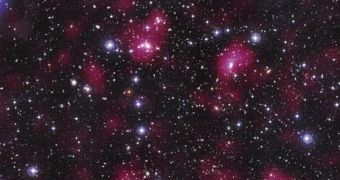We know it's out there, but we can't see it because it doesn't emit light. So how do you find a dark matter cloud? Well, if you consider the fact that most of gravitational fields produced in the universe are associated with dark matter existence, then the problem is solved.
Astrophysicist Catherine Heymans from the University of British Columbia in Vancouver used more than 80 separate images provided by the Hubble Space Telescope to make a map of the dark matter distribution in a region of space stretching 16 light years across. By determining where the gravitational lensing effects due to the dark matter clouds weight take place, Heymans was able to create an accurate map of the dark matter concentrations.
When superimposing the map of the dark matter clouds with the optical pictures of the respective area of space, she realized that the dark matter concentration was mostly greater around galaxy clusters situated 2.6 billion light years away from Earth. Furthermore, the gravitational interactions between the dark matter cloud and the galaxies surrounded by it determine the movement of the previous through the cluster.
The mapped area showing evidence of the presence of large dark matter clouds is clearly visible in the Abell 901/902 galactic supercluser and was detected by studying the light bending effects of the gravitational lens of the cluster on the light coming from over 60,000 other galaxies situated in the background, further behind the cluster.
Each of the gravitational distortions created by the large mass accumulation accurately describes the general area around a few hundred galaxies. By studying the galactic cluster in several light wavelengths, Meghan Gray from the University of Nottingham determined that the motion of the galaxies inside the cluster in mostly dictated by the gravitational pull of the dark matter cloud, which sends the galaxies towards the inner more compact regions of the cluster, where they undergo violent collisions with each other.
During these gravitational interactions, some galaxies might lose massive amounts of molecular gas, which in turn would determine a suppression of the star formation process. On the other hand, the stripped gas would fall towards the inner denser regions.
Nevertheless, the same study revealed that the galaxies in the central regions of the cluster are rather old, with a low star formation process, and less material density. The increased gravitational attraction of the cloud of dark matter surrounding the cluster determines the galaxies to move by each other so fast that the gravitational interactions between them would be insignificant, disabling the possibility of collisions in the central regions.
A more detailed high resolution map of the galactic supercluster Abell 901/902 confirmed the original findings by showing that, indeed, galaxies mostly interact in the outer regions of the cluster rather than in the inner regions. These new findings reveal that the universe might occasionally go through a stage in which the galaxies are moving by each other so fast that they have no time to interact or merge when in the center of a galactic supercluster, while the outer regions seem to be more active than ever.

 14 DAY TRIAL //
14 DAY TRIAL //